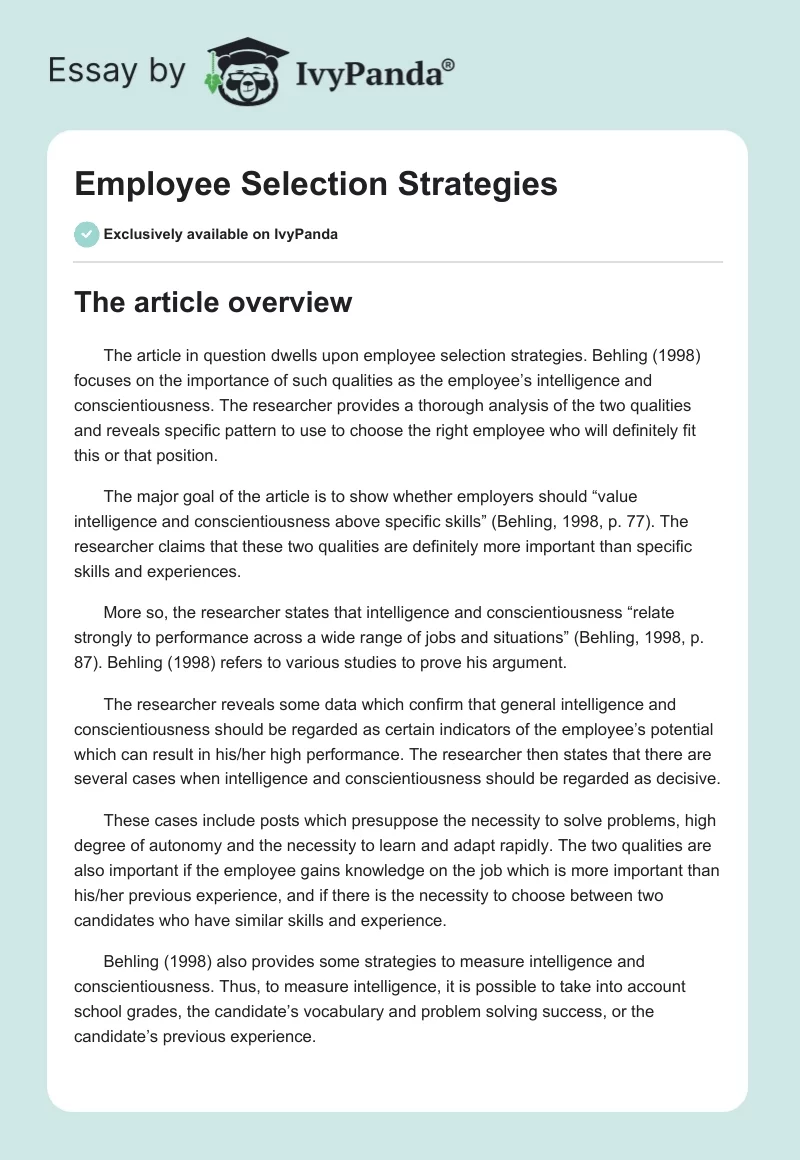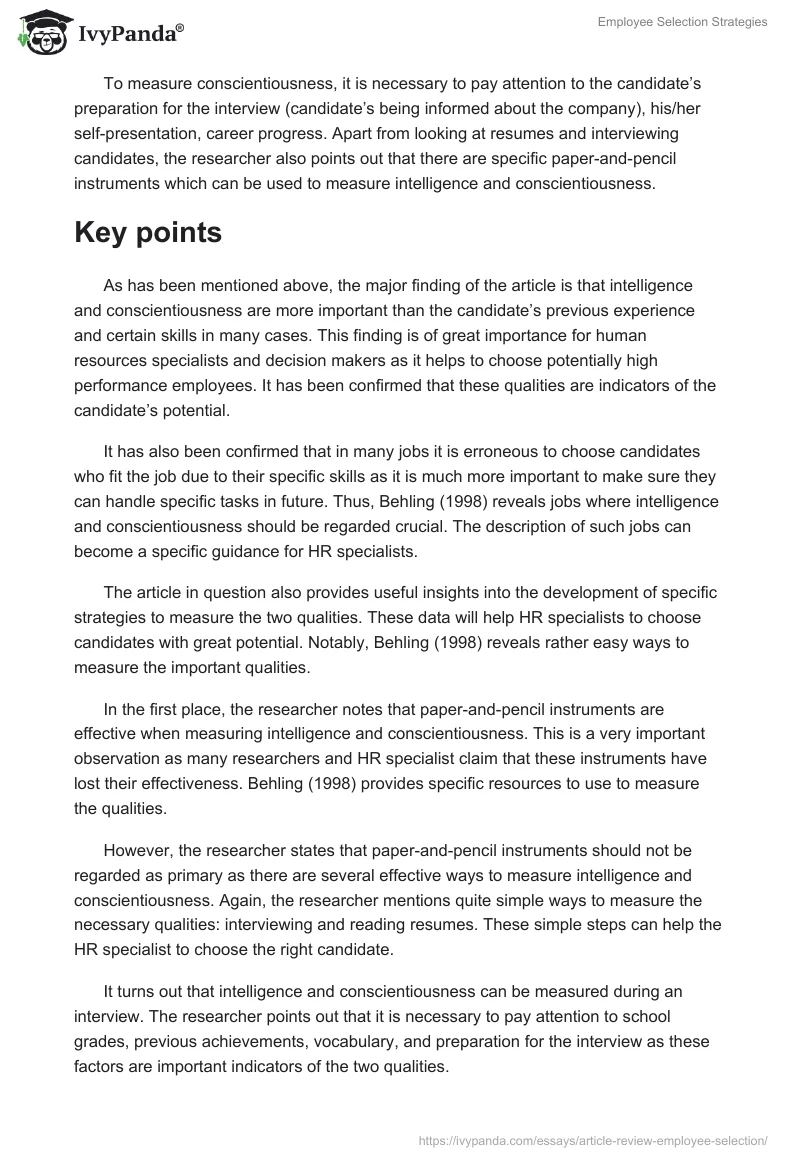The article overview
The article in question dwells upon employee selection strategies. Behling (1998) focuses on the importance of such qualities as the employee’s intelligence and conscientiousness. The researcher provides a thorough analysis of the two qualities and reveals specific pattern to use to choose the right employee who will definitely fit this or that position.
The major goal of the article is to show whether employers should “value intelligence and conscientiousness above specific skills” (Behling, 1998, p. 77). The researcher claims that these two qualities are definitely more important than specific skills and experiences.
More so, the researcher states that intelligence and conscientiousness “relate strongly to performance across a wide range of jobs and situations” (Behling, 1998, p. 87). Behling (1998) refers to various studies to prove his argument.
The researcher reveals some data which confirm that general intelligence and conscientiousness should be regarded as certain indicators of the employee’s potential which can result in his/her high performance. The researcher then states that there are several cases when intelligence and conscientiousness should be regarded as decisive.
These cases include posts which presuppose the necessity to solve problems, high degree of autonomy and the necessity to learn and adapt rapidly. The two qualities are also important if the employee gains knowledge on the job which is more important than his/her previous experience, and if there is the necessity to choose between two candidates who have similar skills and experience.
Behling (1998) also provides some strategies to measure intelligence and conscientiousness. Thus, to measure intelligence, it is possible to take into account school grades, the candidate’s vocabulary and problem solving success, or the candidate’s previous experience.
To measure conscientiousness, it is necessary to pay attention to the candidate’s preparation for the interview (candidate’s being informed about the company), his/her self-presentation, career progress. Apart from looking at resumes and interviewing candidates, the researcher also points out that there are specific paper-and-pencil instruments which can be used to measure intelligence and conscientiousness.
Key points
As has been mentioned above, the major finding of the article is that intelligence and conscientiousness are more important than the candidate’s previous experience and certain skills in many cases. This finding is of great importance for human resources specialists and decision makers as it helps to choose potentially high performance employees. It has been confirmed that these qualities are indicators of the candidate’s potential.
It has also been confirmed that in many jobs it is erroneous to choose candidates who fit the job due to their specific skills as it is much more important to make sure they can handle specific tasks in future. Thus, Behling (1998) reveals jobs where intelligence and conscientiousness should be regarded crucial. The description of such jobs can become a specific guidance for HR specialists.
The article in question also provides useful insights into the development of specific strategies to measure the two qualities. These data will help HR specialists to choose candidates with great potential. Notably, Behling (1998) reveals rather easy ways to measure the important qualities.
In the first place, the researcher notes that paper-and-pencil instruments are effective when measuring intelligence and conscientiousness. This is a very important observation as many researchers and HR specialist claim that these instruments have lost their effectiveness. Behling (1998) provides specific resources to use to measure the qualities.
However, the researcher states that paper-and-pencil instruments should not be regarded as primary as there are several effective ways to measure intelligence and conscientiousness. Again, the researcher mentions quite simple ways to measure the necessary qualities: interviewing and reading resumes. These simple steps can help the HR specialist to choose the right candidate.
It turns out that intelligence and conscientiousness can be measured during an interview. The researcher points out that it is necessary to pay attention to school grades, previous achievements, vocabulary, and preparation for the interview as these factors are important indicators of the two qualities.
Thus, the article in question provides HR specialists and other decision makers with effective instruments which can help to choose the right candidate who will become a high performance employee.
Follow-on research
Admittedly, Behling (1998) provides valuable insights into the process of employee selection. However, it is necessary to note that the researcher does not answer all existing questions (which is quite impossible). Thus, now many issues remain. Thus, Hollenbeck (2009) reports that effective selection strategies are still needed, when it comes to selection of executives.
The researcher argues that one of the major mistakes made in the process of selection of executive is that I-O psychologists are almost never present at the table. The researcher also states that tests and various interviewing techniques available are often insufficient when selecting executives.
The author concludes that it is necessary to work out new ways to assess candidates’ abilities, skills and personal characteristics. Another interesting article is written by Highhouse (2008). The researcher provides data which confirm that nowadays HR specialists often rely on ‘intuition’ when selecting employees.
Surprisingly, HR specialists tend to rely on their experience and ignore standardized tests and various assessment techniques. Highhouse (2008) provides data that verify that this practice often leads to erroneous assessment. Of course, the wrong selection can eventually jeopardize the company’s development.
Admittedly, the two latter works verify the necessity to refer to Behling’s work. The three articles reveal some of the most important areas to research.
Applications
The article in question provides valuable insights into the importance of employee selection which considerably influences the development of the company. It is possible to state that the article confirms the importance of the right choice in employees’ selection. Thus, Behling (1998) reveals major steps to undertake to strengthen the company.
Notably, the researcher explains in simple terms the way employee selection can be improved in different companies. Remarkably, even though the article was published more than a decade ago, it is still up-to-date. Thus, it is clear that not only technological side is important for the success of the company. In fact, employees (or rather the right employees) should be regarded as the major asset in any company.
High performance employees will be able to establish effective technology management which will enable the company to succeed in a highly competitive and rapidly developing world.
Employees, who perfectly fit jobs, can make the right decisions which will lead to the development of the company. It is also important to note that the article can be useful in various setting. More so, it can be a kind of guidance for HR specialist or those who make selection decisions in companies.
Reference List
Behling, O. (1998). Employee selection: Will intelligence and conscientiousness do the job? Academy of Management Executive, 12(1), 77-86.
Highhouse, S. (2008). Stubborn reliance on intuition and subjectivity in employee selection. Industrial and Organizational Psychology, 1, 333-342.
Hollenbeck, G.P. (2009). Executive selection: What’s right… and what’s wrong. Industrial and Organizational Psychology, 2, 130-143.


